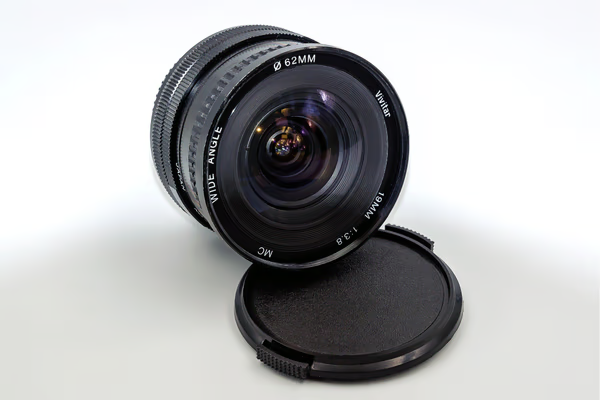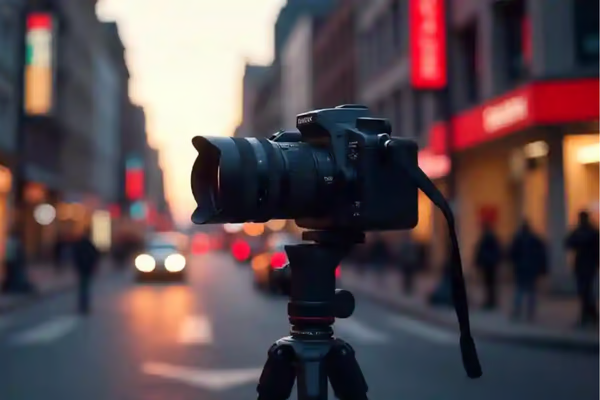Introduction: For many photography enthusiasts, the vintage Vivitar Auto Wide Angle 21mm f/3.8 manual lens is a prized possession. This lens is known for its remarkable build quality and the uniquely beautiful images it produces with its almost wide-open f/4.0 aperture that looks more like f/8.0 in the actual image. This lens not only performs well, but it also lasts a long time. Because it is not an “automatic” lens, the user must set their camera up for manual shooting. But fear not! Many aspects of this vintage lens, which is almost 50 years old, make it usable and enjoyable to work with. And let’s not forget… this lens is a steal!
Complete Guide to the Vintage Auto Wide Angle Vivitar Manual Lens
The classic Vivitar auto wide-angle manual lens offers a mix of quality and craftsmanship that is hard to find in modern lenses. It is well-suited for landscape and architecture photography and large group shots where you must fit many people in the frame. With its wide field of view, this lens also has the advantage of simplicity, as it just wants to be directed at scenes with lots of sharpness and good tonal contrast. Both simplicity and a reliable, “you can count on it” nature make this lens a good choice for honing your creative skills—it’s an excellent way to learn to see what constitutes a solid photograph.
How to Use the Vintage Auto Wide Angle Vivitar Manual for Photography
The vintage wide-angle auto manual lens for an old car from Vivitar takes some work to get used to, but the payoff is enormous. The first thing you have to do is mount it on a suitable camera. Then, for focusing, you have to use your eyes—no auto anything here. You turn the focus ring until the subject looks sharp in the viewfinder. You also have to think: with the auto aperture setting, you’re okay, but for the wide-open aperture, be careful (again, think); with doing any panning shots or sweeps, I suggest you use a tripod because the old lens is prone to some severe vignetting.
Top Features of the Vintage Auto Wide Angle Vivitar Manual Lens
The vintage auto wide-angle Vivitar manual lens has a superpower. It’s a wide-angle lens can capture images with little to no distortion. This quality makes it an ideal candidate for tasks like landscape or architectural photography, where you want the scene in front of you to be rendered as truthfully as possible from a spatial perspective.
If you’ve ever watched a football game on television, you’ve seen distortion in action. A football field is 53.5 feet wide and 360 feet long. To fit that entire space into a photograph, a photographer using a wide-angle lens at the far end of the field would be standing right up against the goalposts—something true only if the distortion-free lens in question had rendered the scene correctly.
Why the Vintage Auto Wide Angle Vivitar Manual Is Perfect for Classic Photography
Classic photography aficionados hold the vintage auto wide angle Vivitar manual lens in high regard because it offers an experience reminiscent of photography’s ‘good old days.’ In contrast to today’s predominantly automatic lenses, the Vivitar’s manual operation allows for a more hands-on approach and a more personalized photographic experience. Indeed, using this lens is all about engaging with choices—obviously not a bad thing at all and indeed a good thing for anyone who enjoys or is a part of the classic photographic community. And if you happen to enjoy the wide-angle aesthetic, this lens delivers that and then some.
Step-by-Step Instructions for Using the Vintage Auto Wide Angle Vivitar Manual
Assemble the lens: Securely attach the classic auto wide angle Vivitar manual exposure lens to the camera body.
Adjust the focus: Turn the focus ring almost unnoticeably to the left or right of the viewfinder.
Set the aperture: Learn how to use it to better control your exposure. Combine it with your shutter speed to achieve a more natural and typical exposure.
Take advantage of the viewfinder: See what an unmodified photo would look like. Once you’ve made the photo, do the same thing again.
Best Cameras Compatible with the Vintage Auto Wide Angle Vivitar Manual Lens
The classic vintage auto wide-angle Vivitar manual lens suits various older camera models, especially manual-focus lenses. It works perfectly with many film cameras from the late 1970s and 1980s—the kinds of cameras that offer an utterly straightforward photography experience. Even some modern digital cameras can use the classic auto wide-angle Vivitar manual with the help of an adapter, which suits filmmakers who want to use an old-school shot-on-film aesthetic. Of course, you should always check that any vintage lens you purchase is compatible with your camera body.
The History and Popularity of the Vintage Auto Wide Angle Vivitar Manual
The auto vintage wide-angle Vivitar manual lens was a favorite during the golden era of film photography. It was a well-respected Vivitar lens that offered excellent performance at an affordable price, which is why it and the other Vivitar lenses “of the time” became a favorite among professionals and amateurs. The lens in this review is the “good” version of the Vivitar wide-angle lens, not the “bad” version of the “not as good” performing lens that you might find at a pawn shop or on an auction site.
How to Maintain Your Vintage Auto Wide Angle Vivitar Manual for Longevity
Regular upkeep is essential to maintain the Vivitar vintage automobile wide-angle Vivitar lens. It has a beautiful finish and an almost delicate appearance—its many tiny serrations are nearly too many to count. But don’t let that facade betray the fact that this is a tested rigid lens. Unlike more recent, almost synthetic-looking plastic designs, the materials of the Vivitar (metal and good optical glass) give the construction a satisfying heft. Like all manual lenses of its generation, it requires good old autofocus for precise focus; however, it’s not really any more difficult to use than more current autofocus lenses.
Vintage Auto Wide Angle Vivitar Manual vs. Modern Lenses: A Detailed Comparison
Today’s lenses frequently provide automatic focusing and other high-tech features. However, my vintage Auto Wide Angle Vivitar manual lens can’t be beaten for simplicity and hands-on use. Unlike modern lenses, which can sometimes feel impersonal, the Vivitar requires the photographer to adjust settings with intention — an ideal condition, I think, for making photographs. The Auto Wide Angle Vivitar is also significantly more durable than most lenses made today. Its solid all-metal construction will likely outlast many modern lenses in a side-by-side longevity competition.
Exploring the Image Quality of the Vintage Auto Wide Angle Vivitar Manual Lens
Renowned for creating images of impressive sharpness and high contrast, the vintage auto wide-angle Vivitar manual lens is well suited for photography where one typically needs a wide-angle lens. It allows for sufficient control over the focus to enable one to shoot at the wide apertures that let in lots of light while allowing one to have as much or as little depth of field as one desires. To be clear, the kinds of photography for which one typically uses a wide-angle lens and a longer exposure time yield a higher risk of camera shake.
Where to Buy Authentic Vintage Auto Wide Angle Vivitar Manual Lenses
Locating a genuine vintage auto wide-angle Vivitar manual lens can be tricky. They are available, though, on many of the online marketplaces we now frequent and on a few specialty photographic retail websites. You can find listings for vintage Vivitar lenses on eBay, Etsy, and some of the dedicated vintage camera retailers now springingspringing up on high streets. When lens shopping, especially if you’re after a vintagyou’re, the same rules that apply to online auto purchases pretty much hold here: Make sure you’re buying an authyou’relens from a seller with solid reviews and return policies.
Top Tips for Maximizing Your Photography with the Vintage Auto Wide Angle Vivitar Manual
To get the best results from your vintage Vivitar wide-angle automatic manual lens, you need to work at it a bit. The first and perhaps most crucial step in this process is to use a tripod. The wide-angle auto has a maximum aperture of f/2.8, which is nothing to sneeze at, but let’s not forget:
Whelet’sng a vintage lens on a full-frame camera like the A7RII, you have a vintage look that includes shallow depth of field. What is substantially more important is ensuring that your images are sharp across the plane of focus with good contrast. That sharpness and contrast …
How do you troubleshoot common issues with the vintage auto wide-angle Vivitar manual?
Begin troubleshooting potential problems with your vintage auto wide-angle Vivitar manual by looking for basic maladies affecting image quality. Like your auto wide-angle Vivitar, vintage or otherwise, vintage cameras’ lenses are susceptible to dust and dirt penetration.
Make sure the lens is clean. Use a lens brush or a very soft cloth, one that you are sure won’t scratch the lens, andwon’t lens cleaner. If you use a lens with an auto mode, don’t forget that it has a don’tl mode, too; if it has auto and manual, it can still use a focus mechanism in either mode. Clean all the components of the camera and the lens. Store it in a safe and dry place when not in use.
Conclusion:
Photographers who favor classic retro cameras are particularly fond of the Auto Wide Angle 19mm f/2.8 lens. They love it for its wide-angle capabilities and unfaltering performance when it comes time to capture the moment. … The manual focus only adds to the particular shooting experience one has with the lens, enabling you to concentrate on the scene and what it is that you want to render through the lens. … What possible tips could there be to make shooters’ experiences better oshooters’ove even more on the “finished” photograph?



